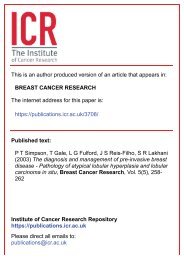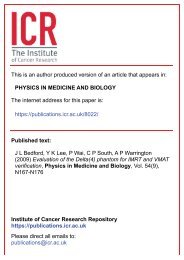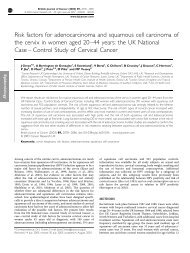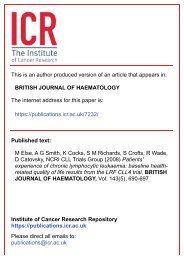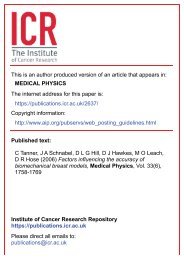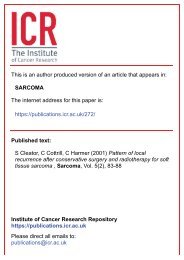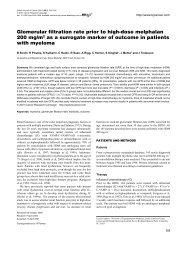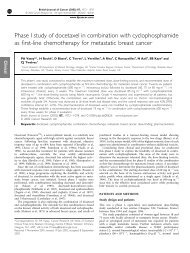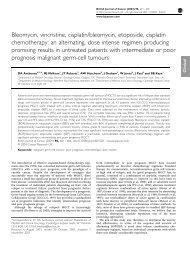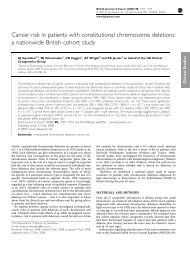Transcriptome analysis of mammary epithelial subpopulations ...
Transcriptome analysis of mammary epithelial subpopulations ...
Transcriptome analysis of mammary epithelial subpopulations ...
Create successful ePaper yourself
Turn your PDF publications into a flip-book with our unique Google optimized e-Paper software.
BMC Genomics 2008, 9:591http://www.biomedcentral.com/1471-2164/9/591enriched in the luminal ER - cells compared to both thebasal/myo<strong>epithelial</strong> and luminal ER + cells. In particular,CD14, Tlr4 and Tnf were expressed at 10-fold, 3-fold and2-fold, respectively, higher levels in the luminal ER - cellscompared to the luminal ER + cells. CD14 and Tnf wereexpressed at 30-fold and 5-fold higher levels in the luminalER - cells compared to the basal/myo<strong>epithelial</strong> cells.Tlr4 expression was undetectable in the basal/myo<strong>epithelial</strong>cells.To determine whether CD14 expression, and thus thepotential to be able to respond to LPS, was a general property<strong>of</strong> all luminal ER - cells or only a subfraction, freshlyisolated primary cells were stained with anti-CD24 andanti-Sca-1 antibodies, to enable the three main cell compartmentsto be identified, as well as with anti-CD14 andanti-CD61 (proposed as a marker <strong>of</strong> progenitor cells) [11]antibodies. The results (Figure 6A) showed that theCD24 +/High Sca-1 - luminal ER - population is itself composed<strong>of</strong> four different <strong>subpopulations</strong>, namely CD14 -CD61 - cells, CD14 + cells, CD61 + cells and CD14 + CD61 +cells. Interestingly, a small number <strong>of</strong> CD24 +/Low Sca1 -basal cells also showed elevated levels <strong>of</strong> CD61 expression.The luminal ER + gene expression pattern is not an'estrogen-responsive' gene expression signatureUpon examination <strong>of</strong> the luminal ER + gene network, wenoted that few <strong>of</strong> the genes enriched in the luminal ER +population were directly linked to ESR1 by transcriptionalinteractions, with the exception <strong>of</strong> the progesterone receptor(PGR) [39] and the cytoskeletal protein keratin 19(KRT19) [40]. This suggested that the gene signature <strong>of</strong> theluminal ER + cells was not an 'estrogen responsive' genesignature. Rather, it was more likely to represent an underlyingstable gene expression pattern characteristic <strong>of</strong> thisdifferentiated cell population. To investigate this further,we compared lists <strong>of</strong> estrogen responsive genes reportedin studies <strong>of</strong> estrogen-stimulated normal human <strong>mammary</strong><strong>epithelial</strong> cells [25,26] and breast cancer cell lineswith our lists <strong>of</strong> genes expressed in the <strong>epithelial</strong> <strong>subpopulations</strong>[22-24]. The results [see Additional file 18] confirmedthat there was little correlation between 'estrogenresponsive'signatures and the genes enriched in the luminalER + population. Indeed, many <strong>of</strong> the gene whoseexpression was stimulated by estrogen in the breast cancercell lines were found to be enriched in our basal/myo<strong>epithelial</strong>population. However, it should be noted that thewell-known directly estrogen responsive genes KRT19 andPGR, were not found to be upregulated in most <strong>of</strong> thepublished datasets.Identification <strong>of</strong> basal/myo<strong>epithelial</strong> cells as key mediators<strong>of</strong> paracrine signallingHaving identified key processes likely to be occurringwithin each <strong>of</strong> the three populations, we next investigatedhow the populations might be interacting with eachother. Mammary <strong>epithelial</strong> biology is characterised by theconversion <strong>of</strong> systemic hormone signals into local growthfactor signals which stimulate stem cell proliferation anddifferentiation <strong>of</strong> daughter cell types. Whilst some <strong>of</strong> theseparacrine interactions have been studied in depth[15,17,41], the broad extent <strong>of</strong> paracrine networks withinthe <strong>mammary</strong> epithelium remains unknown. We thereforequeried the gene expression array data for genespotentially involved in paracrine signalling, either asreceptors or ligands (where there was a conflict betweenthe gene expression array and qPCR data, the distributionpredicted by the qPCR data was favoured). A number <strong>of</strong>genes were identified which fulfilled these criteria [seeAdditional file 19]. Remarkably, they showed that thebasal/myo<strong>epithelial</strong> cells have more than double the complement<strong>of</strong> cell-surface receptors and ligands than either<strong>of</strong> the two luminal populations. Of particular interest, thebasal/myo<strong>epithelial</strong> cells expressed the genes for theNotch family ligands, Jag1, Jag2 and Dll1 [42] whilst thegene for the Notch family receptor Notch3 [43] wasexpressed in both the luminal populations. Wnt familyligands were expressed by all three populations, althougheach cell type expressed a different complement <strong>of</strong> Wntgenes and only the basal/myo<strong>epithelial</strong> cells expressed thegenes for the Frizzled receptors [44].It is well established that Egf receptor family members andEgf family ligands are important for <strong>mammary</strong> glanddevelopment and breast cancer [45,46]. In particular, theparacrine role <strong>of</strong> Amphiregulin (Areg) is well described[15,41,47,48]. Our <strong>analysis</strong> confirmed that luminal ER +<strong>mammary</strong> <strong>epithelial</strong> cells expressed the Areg gene but alsoshowed that the genes for two other family members,Betacellulin (Btc) [49] and Epigen (Epgn) [50], wereexpressed in this cell type and Btc was also expressed in theluminal ER - cells. Interestingly, only one Egf receptor familymember, Erbb3 [51], was found by gene expressionarray and qPCR <strong>analysis</strong> to be differentially expressed inthe normal <strong>mammary</strong> epithelium. It was present in boththe luminal <strong>epithelial</strong> populations but not in the basal/myo<strong>epithelial</strong> cells.This <strong>analysis</strong> extends previous findings <strong>of</strong> paracrine signallingwithin the <strong>mammary</strong> epithelium and emphasisesthe complexity <strong>of</strong> the interacting signalling networks.These include Wnt and Notch signalling, the Egf family,Fgf signalling, other receptor tyrosine kinases, G-proteincoupled receptors, ligands for such receptors, integrinsand ephrins/Eph receptors all <strong>of</strong> which are differentiallyexpressed between the cell populations. In particular, thenumbers <strong>of</strong> ligands and receptors expressed by the basal/myo<strong>epithelial</strong> cells indicates that this population is a keymediator <strong>of</strong> the paracrine signalling networks within the<strong>mammary</strong> epithelium.Page 12 <strong>of</strong> 28(page number not for citation purposes)



